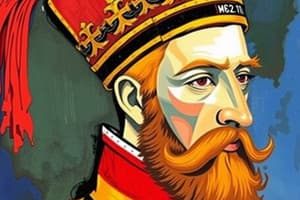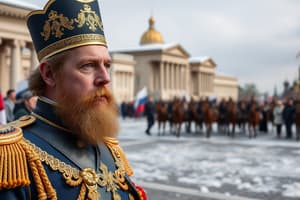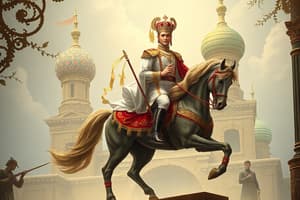Podcast
Questions and Answers
What was the overall nature of Alexander II's control over central administration?
What was the overall nature of Alexander II's control over central administration?
- He shared power with ministers.
- He had complete control over all aspects. (correct)
- He delegated authority to local governments.
- There were significant changes leading to a constitutional monarchy.
What can be said about the presence of reforms during Alexander II's reign?
What can be said about the presence of reforms during Alexander II's reign?
- No reforms were implemented during his time.
- Reforms were only introduced after 1880.
- Reforms predominantly occurred before 1866. (correct)
- Reforms were consistent and significant throughout his reign.
What was a notable aspect of the Loris-Melikov reforms proposed by Alexander II?
What was a notable aspect of the Loris-Melikov reforms proposed by Alexander II?
- They aimed to abolish the monarchy.
- They would have created Russia's first advisory constituent assembly. (correct)
- They were rejected entirely by the tsar.
- They involved eliminating all forms of serfdom immediately.
How did Alexander II's methodology change during his reign?
How did Alexander II's methodology change during his reign?
Which statement reflects the continuity of Alexander II's tsarism during his rule?
Which statement reflects the continuity of Alexander II's tsarism during his rule?
What can be inferred about the changes in the apparatus of central government during Alexander II's reign?
What can be inferred about the changes in the apparatus of central government during Alexander II's reign?
What was one of the key aims of Alexander II during his reign?
What was one of the key aims of Alexander II during his reign?
In what ways did the nature of Alexander II's rule maintain continuity?
In what ways did the nature of Alexander II's rule maintain continuity?
What was one of the primary reasons for Alexander II's reluctance to allow serfs greater mobility?
What was one of the primary reasons for Alexander II's reluctance to allow serfs greater mobility?
How many peasant revolts occurred between 1844 and 1854 prior to the Crimean War?
How many peasant revolts occurred between 1844 and 1854 prior to the Crimean War?
What method did Nicholas I use to restore order during peasant revolts?
What method did Nicholas I use to restore order during peasant revolts?
What was the primary role of Kartogas during Alexander II's reign?
What was the primary role of Kartogas during Alexander II's reign?
Which action indicated the ineffectiveness of the Third Section under Alexander II?
Which action indicated the ineffectiveness of the Third Section under Alexander II?
What reform was considered one of Alexander II's most radical changes?
What reform was considered one of Alexander II's most radical changes?
What was a significant outcome of the trials involving Populists during Alexander II's rule?
What was a significant outcome of the trials involving Populists during Alexander II's rule?
What characterizes the government's structure under Alexander II?
What characterizes the government's structure under Alexander II?
In what context was the army used during the Polish Revolt of 1864?
In what context was the army used during the Polish Revolt of 1864?
What major change to governance was made as a reform to improve administration during Alexander II's reign?
What major change to governance was made as a reform to improve administration during Alexander II's reign?
What was the purpose of the Imperial Council of State during Alexander II's rule?
What was the purpose of the Imperial Council of State during Alexander II's rule?
Which section was removed when the Committee of Ministers was introduced in 1861?
Which section was removed when the Committee of Ministers was introduced in 1861?
What role did the Okhrana serve in Alexander II's administration?
What role did the Okhrana serve in Alexander II's administration?
What change did Alexander II make to the process of drafting legislation with the introduction of the Committee of Ministers?
What change did Alexander II make to the process of drafting legislation with the introduction of the Committee of Ministers?
Which of the following represented a common ideological divide among Alexander II's ministers?
Which of the following represented a common ideological divide among Alexander II's ministers?
What was a primary function of the Senate during Alexander II's reign?
What was a primary function of the Senate during Alexander II's reign?
What was the main reason for Alexander II's introduction of the Committee of Ministers?
What was the main reason for Alexander II's introduction of the Committee of Ministers?
Which ministerial role was NOT considered one of the four most important in the Committee of Ministers?
Which ministerial role was NOT considered one of the four most important in the Committee of Ministers?
What was the significant shift regarding the secret police during the period of 1880-1881?
What was the significant shift regarding the secret police during the period of 1880-1881?
How did the public perceive the Third Section, leading to its removal?
How did the public perceive the Third Section, leading to its removal?
What was a common position regarding serfdom among the Slavophiles?
What was a common position regarding serfdom among the Slavophiles?
Which minister was primarily responsible for educational reforms during Alexander II's reign?
Which minister was primarily responsible for educational reforms during Alexander II's reign?
Which of the following was NOT a role of the Council of Ministers after 1861?
Which of the following was NOT a role of the Council of Ministers after 1861?
What reform was associated with the shift to the Okhrana during Alexander II's rule?
What reform was associated with the shift to the Okhrana during Alexander II's rule?
What method did Alexander II utilize to exercise control over the population?
What method did Alexander II utilize to exercise control over the population?
Who was the Grand Duke involved in multiple governmental roles during Alexander II's rule?
Who was the Grand Duke involved in multiple governmental roles during Alexander II's rule?
Which factor influenced Alexander II's decision-making regarding serfdom?
Which factor influenced Alexander II's decision-making regarding serfdom?
Which period saw a significant increase in educational opportunities in Russia under Alexander II?
Which period saw a significant increase in educational opportunities in Russia under Alexander II?
What was a notable impact of the Press Law passed in 1865 during Alexander II's reign?
What was a notable impact of the Press Law passed in 1865 during Alexander II's reign?
Which of the following statements is true regarding the censorship during Alexander II's reign?
Which of the following statements is true regarding the censorship during Alexander II's reign?
What change occurred in the ministerial appointments following the assassination attempts during Alexander II's reign?
What change occurred in the ministerial appointments following the assassination attempts during Alexander II's reign?
Which liberal minister was responsible for the Emancipation of the Serfs?
Which liberal minister was responsible for the Emancipation of the Serfs?
In what way did Alexander II's methods of control change over his reign?
In what way did Alexander II's methods of control change over his reign?
Which individual served as head of the Third Section during the latter part of Alexander II’s reign?
Which individual served as head of the Third Section during the latter part of Alexander II’s reign?
What impact did the 1861 reform on primary education have during Alexander II's rule?
What impact did the 1861 reform on primary education have during Alexander II's rule?
What was a central feature of the emancipation of serfs regarding land and payments?
What was a central feature of the emancipation of serfs regarding land and payments?
What was the primary goal motivating Alexander II's method changes with his ministers?
What was the primary goal motivating Alexander II's method changes with his ministers?
Which was a consequence of the reforms in the education system under Alexander II?
Which was a consequence of the reforms in the education system under Alexander II?
Flashcards are hidden until you start studying
Study Notes
Tsar and Central Administration
- Alexander II remained an absolute monarch from 1855 to his assassination in 1881, maintaining control over central administration.
- Aimed to modernize Russia while managing autocracy, military reform, and serfdom consequences.
- Tsarism experienced no massive changes in its core functions, though methods of governance evolved over time.
Parts of Central Government
- Three periods highlight the structure of central government:
- 1855-1861: Personal Chancellery, Imperial Council of State, Council of Ministers, and Senate structured governance.
- 1861-1880: Introduction of the Committee of Ministers, improving administrative efficiency and adding an advisory layer.
- 1880-1881: Okhrana replaced the Third Section of the Personal Chancellery, maintaining the same security functions but modernized.
Changes in Ministers
- Ministerial appointments reflected Alexander II's balancing act between reformers and conservatives:
- 1855-1866: Predominance of Westerniser liberals supporting reforms.
- 1867-1880: Shift to conserve control amidst assassination attempts, with conservatives placed in strategic ministries.
- The ideological divides between Westernisers (liberal reformers) and Slavophiles (traditionalists) influenced governance and policy decisions.
Methods of Control
- Censorship laws became relatively liberal compared to previous regimes, with increased publications and reduced preliminary censorship.
- Education reform expanded access at primary and university levels, with some controls instituted under Dmitry Tolstoy to manage revolutionary ideas.
- Emancipation of the serfs included strict land distribution and redemption payments to prevent destabilization of society.
- The army was used to quell peasant revolts, notably in 1861 after emancipation, resulting in decreased resistance by the mid-1860s.
- Kartogas were employed for exiling dissenters, continuing a long-standing Russian practice.
- The Third Section, and later the Okhrana, faced inefficiencies yet retained primary responsibilities for state security and opposition management.
- Judicial reforms aimed to improve public trust; however, trials of political dissidents caused backlash and led to increased control over political crimes.
Concluding Points
- While some administrative changes occurred under Alexander II, such as the Committee of Ministers, the overall structure of central government and tsarist authority remained intact.
- Ministers and control methods showcased a balance of reforms and repression, aligning with the tsar's overarching goals throughout his reign.
Studying That Suits You
Use AI to generate personalized quizzes and flashcards to suit your learning preferences.




